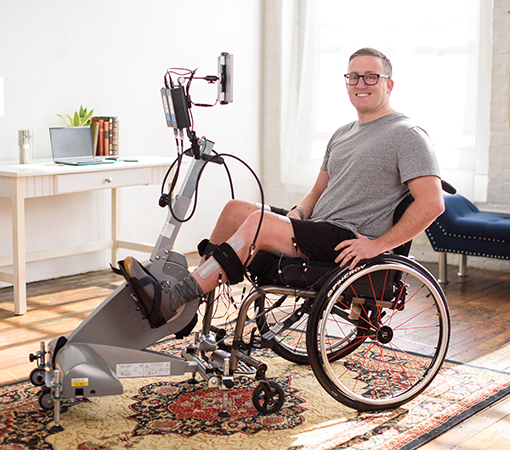Functional Electrical Stimulation Bike, In the world of rehabilitation and physical therapy, innovative technologies are continually emerging to help individuals regain mobility and improve their quality of life. One such groundbreaking device is the Functional Electrical Stimulation (FES) bike. This device has shown remarkable potential in aiding those with mobility impairments, particularly individuals suffering from neurological conditions such as stroke, spinal cord injuries, or multiple sclerosis.
What is a Functional Electrical Stimulation Bike?
A Functional Electrical Stimulation (FES) bike is a specialized exercise machine that combines traditional cycling with electrical stimulation to activate muscles that may be weak or paralyzed. Unlike conventional stationary bikes, the FES bike uses electrical impulses to stimulate the muscles, allowing patients to pedal and engage in physical activity even if they are unable to do so independently due to limited muscle control.
The bike is equipped with electrodes that send electrical signals to the muscles, causing them to contract and simulate the natural movement of cycling. This technology is particularly beneficial for individuals with conditions that impair motor function, such as those with spinal cord injuries, stroke survivors, or people with muscular dystrophy. FES enables these patients to experience the benefits of cycling, which otherwise may have been out of reach.
How Does the FES Bike Work?
The core functionality of an FES bike lies in its ability to use electrical stimulation to activate muscle groups that have lost the ability to function voluntarily. The process is as follows:
- Electrode Placement: Small electrodes are placed on the skin over the targeted muscles. These electrodes are connected to a controller that administers electrical impulses.
- Electrical Stimulation: The controller sends electrical impulses to the muscles, causing them to contract. The stimulation mimics the natural signals that the brain sends to the muscles during movement.
- Pedaling Movement: As the muscles contract, they allow the individual to perform the motion of pedaling. In the case of patients who have limited mobility, this motion is typically assisted by the electrical stimulation.
- Exercise and Rehabilitation: The bike provides both a cardiovascular workout and a means to strengthen the lower body muscles, improving circulation, muscle tone, and overall function.
Benefits of Using an FES Bike
- Improved Muscle Strength: Regular use of the FES bike can help improve the strength of weakened muscles. This is especially beneficial for individuals with paralysis or partial paralysis, as it can help maintain or even increase muscle mass that might otherwise atrophy due to inactivity.
- Enhanced Mobility: For patients with spinal cord injuries or neurological impairments, the FES bike can aid in improving motor function and coordination. The repeated motion of pedaling can help retrain the nervous system and promote neuroplasticity, which is the brain’s ability to form new connections and pathways.
- Increased Circulation: Cycling with an FES bike helps stimulate blood flow to the lower extremities. This increased circulation can reduce the risk of blood clots and improve overall cardiovascular health.
- Prevention of Complications: For individuals who are sedentary due to injury or illness, the FES bike can help reduce the risk of complications such as muscle wasting, joint stiffness, and pressure ulcers, by promoting regular movement and exercise.
- Psychological Benefits: Being able to engage in physical activity, even with limited mobility, can significantly boost a patient’s morale. It provides a sense of accomplishment and autonomy, which is vital for emotional well-being during the recovery process.
- Functional Independence: Over time, the use of an FES bike can contribute to greater functional independence by improving muscle function and joint mobility. This can enable individuals to perform daily tasks with less assistance, enhancing their quality of life.
Who Can Benefit from an FES Bike?
The Functional Electrical Stimulation bike is designed for a wide range of patients with different conditions. Some of the most common beneficiaries include:
- Individuals with Spinal Cord Injuries (SCI): SCI patients often experience paralysis in their lower limbs, making it difficult or impossible to engage in traditional exercise. FES bikes can help stimulate muscle movement and improve cardiovascular health.
- Stroke Survivors: Stroke patients may have impaired motor control, particularly on one side of the body. FES bikes can assist in regaining some of the lost movement and improving coordination.
- Multiple Sclerosis (MS) Patients: MS can cause muscle weakness and coordination issues. The FES bike can help MS patients maintain strength and reduce the risk of complications from immobility.
- Individuals with Muscular Dystrophy: For those with degenerative muscle conditions like muscular dystrophy, the FES bike provides a low-impact way to exercise without straining the body.
Conclusion
The Functional Electrical Stimulation (FES) bike represents a revolutionary step forward in rehabilitation technology, offering new hope for patients with mobility impairments. By combining electrical stimulation with physical activity, it provides users the opportunity to engage in regular exercise, improve muscle strength, and enhance overall quality of life. As research and development continue, the FES bike may become an increasingly essential tool in therapeutic settings and home care, making it a key player in the journey toward recovery and independence for individuals with neurological conditions.
You Might Also Like These:

